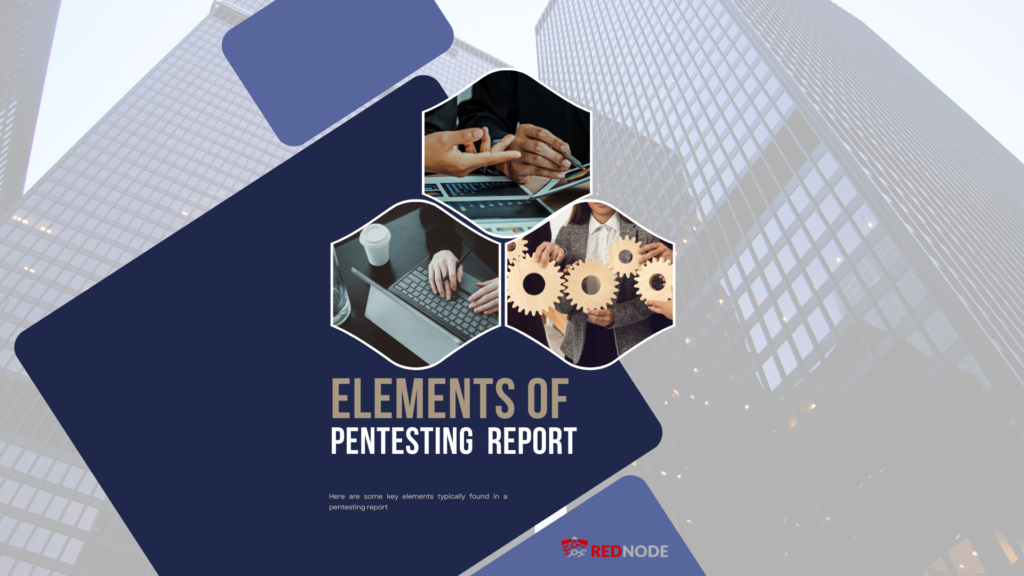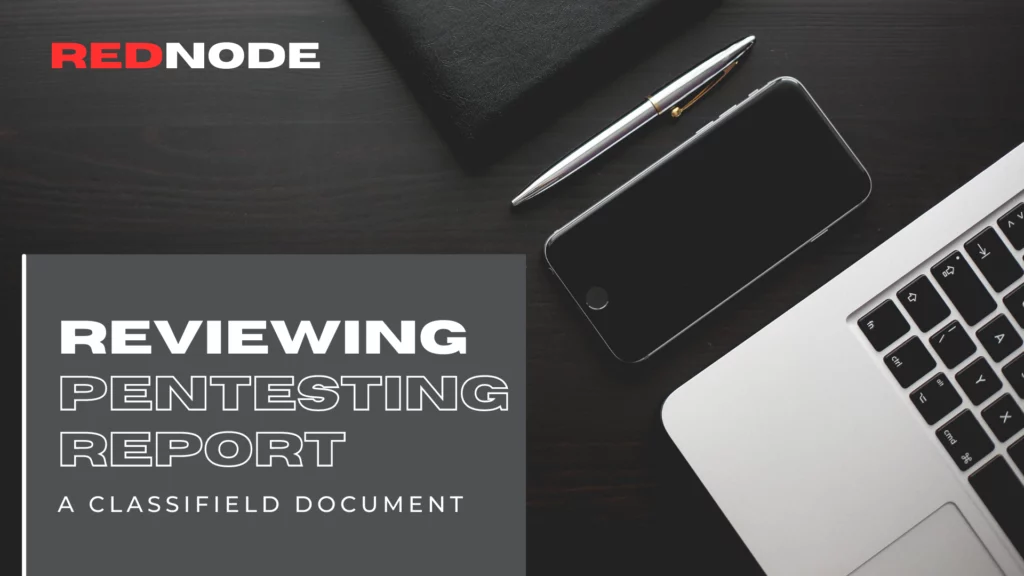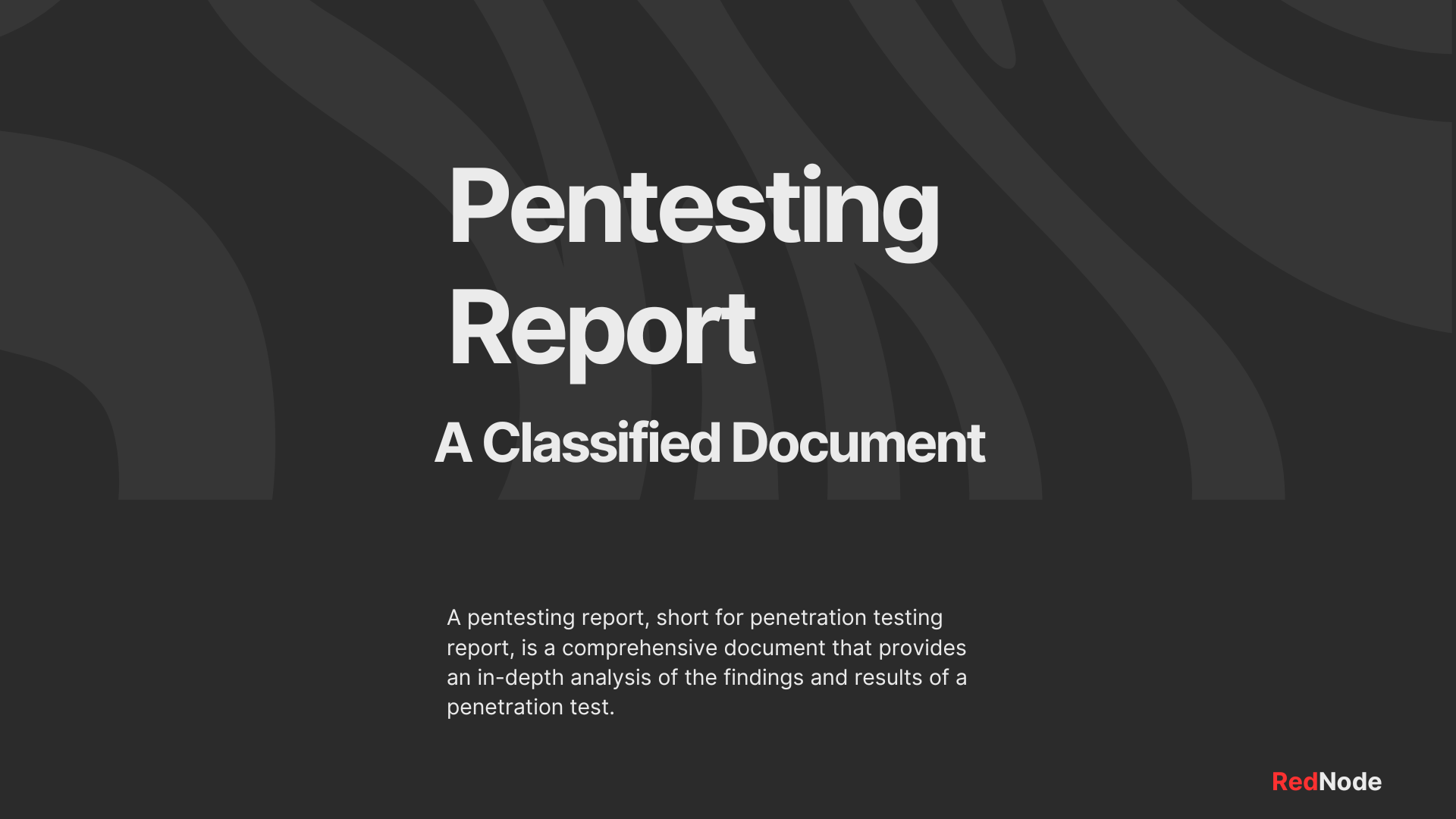A pentesting report, short for penetration testing report, is a comprehensive document that provides an in-depth analysis of the findings and results of a penetration test. Penetration testing, often referred to as “pentesting”, is a controlled and simulated cyber attack on a system, network, application, or organization’s infrastructure, conducted to identify security vulnerabilities and vulnerabilities.
The primary purpose of a pentesting report is to communicate the results of the security assessment to relevant stakeholders, such as management, the IT team, and security professionals. The report should include detailed information about the identified vulnerabilities, their potential impact on the organization’s security, and recommended remedial actions to address and mitigate these issues.

Elements of a Pentesting Report
Here are some key elements typically found in a pentesting report:
- Executive Summary: This section provides a high-level overview of the pentesting process, objectives, and key findings. It is usually designed for non-technical stakeholders, summarizing key risks and recommended actions.
- Methodology: The report must outline the scope of the penetration test and the methodology employed by the testers during the test. This ensures clarity and allows the readers to understand the examination procedure.
- Detailed Findings: This section provides an in-depth analysis of each discovered vulnerability. It includes information such as the name of the vulnerability, its severity level, the system affected, and steps to reproduce it. Screenshots and code snippets can be included for clarity.
- Risk Rating: A risk rating should be assigned based on the potential impact and exploitability of each identified vulnerability. Common rating scales include “low,” “moderate,” “high,” and “critical.”
- Impact analysis: The report should discuss the potential impact of identified vulnerabilities on the organization’s assets, data and operations. This helps stakeholders understand the potential consequences of these security vulnerabilities.
- Recommendations: For each vulnerability, the report should include actionable and prioritized recommendations for remediation. These recommendations may vary based on the severity and criticality of the vulnerability.
- Supporting Evidence: The report should include any additional evidence to support the findings, such as log files, configuration files, or proof-of-concept code.
- Appendix: This section may contain additional technical details, a glossary of terms, and references to external resources.
Understanding a pentesting report requires basic knowledge of cybersecurity concepts and technical jargon. If you’re not familiar with cybersecurity terminology, it’s a good idea to engage IT or cybersecurity professionals who can interpret the report and guide the organization in implementing the recommended fixes.
How to Use A pentesting Report
As a company owner, a pentesting report can provide valuable insight into your organization’s security posture. It allows you to understand the weaknesses and vulnerabilities that exist within your systems, applications and network infrastructure To make the most of Pentesting reports and increase your company’s security, follow these steps:
- Review the Executive Summary: Start by reading the Executive Summary to get a high-level overview of the findings, risks, and recommendations. This will give you a quick understanding of security issues that need attention
- Understand Vulnerabilities: Dive into the detailed investigation section to understand specific vulnerabilities identified during penetration testing. Pay close attention to critical and high-risk vulnerabilities that could lead to potentially serious consequences.
- Prioritize remediation efforts: Work with your IT and security teams to prioritize remediation efforts based on risk ratings and the potential impact of each vulnerability. Focus on solving the most critical problems first to effectively reduce overall risk.
- Hire the right experts: If your IT team lacks the expertise to address certain vulnerabilities, consider hiring external cyber security experts or consultants to assist with remediation efforts. Their experience can be invaluable in solving complex security problems.
- Create a remediation plan: Create a detailed plan that outlines steps to address each vulnerability, including timelines, responsibilities, and milestones. Make sure this plan aligns with your organization’s operational and budgetary constraints.
- Monitor progress: Regularly track the progress of remediation efforts and hold your team accountable for meeting established milestones. Stay informed about the revision status and any challenges faced during the process.
- Implement preventive measures: In addition to addressing vulnerabilities identified in pentesting reports, consider implementing preventive security measures. This may include regular security awareness training for employees, implementation of multi-factor authentication, and continuous monitoring of network activity.
- Periodic retesting: Schedule regular follow-up pen tests to verify the effectiveness of remediation efforts and identify new vulnerabilities that have arisen since the last assessment.
- Share learning across the organization: Use pentesting report findings to educate employees and other stakeholders about cybersecurity best practices and the importance of maintaining a security-aware culture.
- Stay Informed: Keep yourself updated with the latest security trends, threats and best practices in the industry. Cybersecurity is an ever-evolving field, and staying informed will help you make informed decisions to protect your company from emerging threats.
- Establish a security policy: Create a comprehensive security policy for your organization that outlines personnel roles and responsibilities, security protocols, and incident response procedures. Ensure that all employees are aware of and adhere to this policy.
By gaining insights from pentesting reports and proactively addressing identified vulnerabilities, you can significantly improve your company’s cybersecurity posture, reduce the risk of security breaches, and protect your valuable assets and sensitive data.

Reviewing Pentesting Report
When reviewing a pentesting report, consider the following steps:
Read the Executive Summary: Start with the Executive Summary to get a quick overview of key findings and risks.
- Focus on critical outcomes: Pay particular attention to vulnerabilities of high and critical severity, as they represent the most significant risk.
- Review recommendations: Examine proposed remedial actions and prioritize them based on their potential impact and complexity.
- Engage experts: If necessary, engage cybersecurity experts within your organization or hire external consultants to help resolve identified issues.
- Monitor progress: Keep track of progress in fixing vulnerabilities and verify that recommended actions are effectively implemented.
Pentesting reports play an important role in improving an organization’s security posture by highlighting vulnerabilities and guiding remediation processes. Properly understanding and acting on the findings can significantly increase an organization’s resilience against cyber threats.
What will happen if the Pentesting Report falls into the wrong hands?
If a pentesting report falls into the wrong hands, it can have serious consequences for the penetration testing organization. Here are some risks and effects:
- Vulnerability Disclosure: The report contains detailed information about vulnerabilities and weaknesses identified in the organization’s systems and infrastructure. If this information falls into the hands of malicious actors, they can exploit these vulnerabilities to launch a true cyber attack, causing damage, breaching data, or disrupting the organization’s operations.
- Data breach: Pentesting reports may contain sensitive information about the organization’s network architecture, access credentials, and other confidential data. Unauthorized access to this information can lead to data breaches, exposing sensitive customer information, intellectual property, financial information, and other important assets.
- Damage to Reputation: Violation of pentesting reports can seriously damage an organization’s reputation, destroying trust among customers, partners, and stakeholders. This can be perceived as a failure to protect sensitive data and protect customer information, resulting in lost business opportunities.
- Legal and compliance issues: Depending on the nature of the information disclosed, organizations may face legal repercussions and regulatory penalties for failing to adequately protect sensitive data. This may violate contractual agreements with clients, leading to potential legal disputes.
- Loss of competitive advantage: If the report falls into the hands of competitors, they may gain insight into the organization’s security vulnerabilities, potentially undermining its competitive advantage.
- Financial losses: A successful cyber attack resulting from the publication of pentesting reports can cause significant financial losses, including costs associated with incident response, data recovery, legal action, and reputational damage.
Prevent falling into the wrong hands
To prevent these potential risks, companies should take the following measures to protect their pentesting reports:
- Restricted Access: Limit access to pentesting reports to authorized personnel only. Use strong encryption and access controls to protect the document from unauthorized access.
- Secure storage: Store the report in a secure location, preferably on an isolated network segment or on a password-protected file-sharing platform with strict access controls.
- Proper disposal: After reviewing the report and implementing recommended actions, ensure safe disposal of physical and digital copies of the report.
- Non-Disclosure Agreements (NDAs): All parties involved in penetration testing, including the testing team and any third-party consultants, must sign NDAs to ensure confidentiality and legal consequences in the event of a breach.
- Redaction: Before sharing the report with non-technical stakeholders or external parties, redact sensitive information to reduce the potential risk if the document accidentally falls into the wrong hands.
- Secure communication: If the report needs to be shared electronically, use secure channels such as encrypted email or a secure file-sharing platform.
By following these practices, organizations can significantly reduce the likelihood of a pentesting report falling into the wrong hands and reduce the potential risks associated with such an incident.
RedNode, a trusted and experienced cybersecurity firm, has been securing the cyber world for over a decade. With an unmatched track record, RedNode brings extensive expertise to effectively address various cyber threats. Expert in conducting comprehensive penetration testing, their team of skilled professionals is equipped to fortify your organization’s infrastructure against potential security breaches. RedNode’s tailored approach provides deep insight into your system’s vulnerabilities, ensuring a thorough vulnerability assessment.
By hiring RedNode to conduct a pentest, you’ll benefit from their industry-leading knowledge and state-of-the-art methods, ensuring critical security risk identification and prioritization. Their diligent and meticulous reporting empowers you to proactively address vulnerabilities, strengthen your defenses, and protect sensitive data from malicious actors. Choosing RedNode demonstrates a commitment to robust cyber security practices, instilling confidence among stakeholders and clients alike. With RedNode as your trusted cyber security partner, you can rest assured that your infrastructure will be resilient and protected against cyber threats for years to come.

